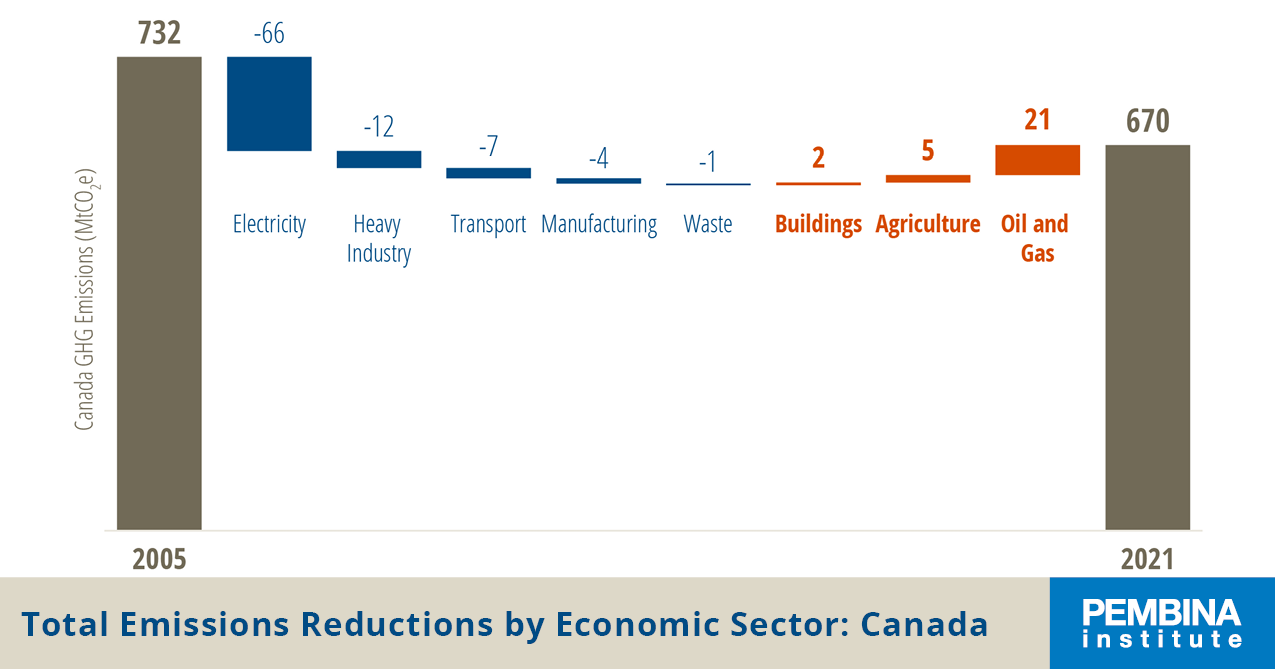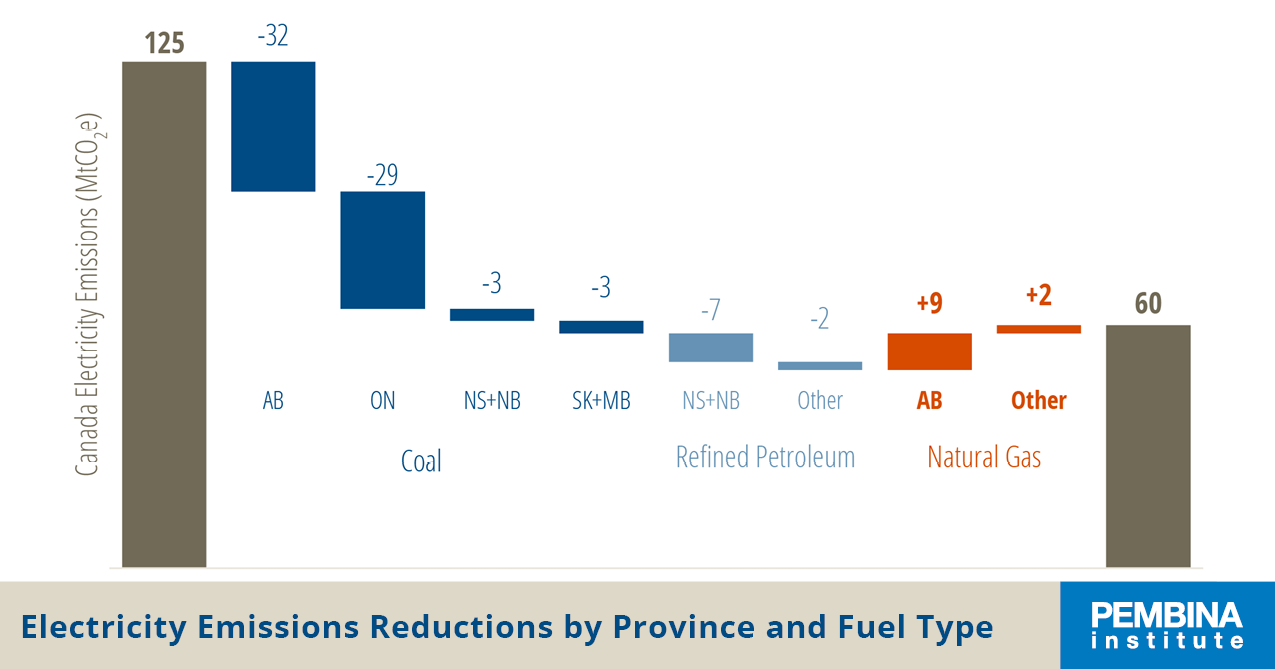Data released in Canada’s latest National Inventory Report (NIR) suggests policies and regulations are starting to have an impact. Emissions declined by 8.4 per cent from 2005 levels. The long-term trends are promising but we need to significantly accelerate the pace if we are to achieve our 2030 targets.
The National Inventory Report, submitted annually to the United Nations Framework Convention on Climate Change (UNFCCC), holds Canada accountable to targets committed to under the UNFCCC. This includes reducing emissions by 40-45 per cent below 2005 levels by 2030.
The NIR provides important information for where we can improve our emissions reductions across sectors and provinces.

Oil and gas – Emission rise points to need for a cap
The oil and gas sector continues to be Canada’s largest emitting sector, representing 28 per cent of Canada’s total emissions, according to the report. As such, significant reductions in this sector can have a huge impact on Canada’s emissions profile.
One area where the NIR indicates regulations are starting to have an effect is methane. Oil and gas methane (including from fugitive sources, stationary combustion in oil and gas production, and pipeline transport) decreased 33 per cent from 2012 levels. And, despite an increase in production, operating wells and wells drilled, oil and gas methane stayed stable between 2020 and 2021. This points to the effectiveness of Canada’s methane regulations which, in 2020, introduced a standard to cut greenhouse gases by 20 Mt annually. It also indicates the importance of setting targets in regulations.
Despite this progress, emissions from the oil and gas sector remain problematic as emissions continue to rise. The NIR shows oilsands production alone had emissions increase by 9 per cent over the year. This points to the need for more rules to reduce emissions in this sector, such as the oil and gas cap.
An oil and gas cap is needed to ensure emissions from the sector decline and the sector does its fair share in contributing to Canada’s climate targets. It will hold industry accountable to their net-zero pledges. A 40 to 45 per cent 2030 target will be critical for reducing emissions from this sector at the pace and magnitude necessary for achieving Canada’s 2030 goals.
Transportation – Zero emissions vehicle mandate must be finalized
Transportation pulled in at a close second to oil and gas this year, accounting for almost a quarter of the nation’s emissions. The NIR shows a 4.9 per cent increase over the year in emissions generated by the transportation sector, in part due to increased travel activity following COVID-19 restrictions. This is not surprising as the economy was starting back up. However, given the reporting delay in NIR data, this figure will likely increase in subsequent years.
A medium- and heavy-duty vehicle (MHDV) sector sales mandate is critical to meet the Emissions Reduction Plan targets of 35 per cent zero-emissions vehicles (ZEV) by 2030 and 100 per cent ZEV where feasible by 2040. HDVs account for 37 per cent of the transportation sector’s emissions and the NIR shows emissions in this sector soared in comparison to other forms of transportation.
Canada must also finalize ZEV mandates for light-duty vehicles and invest significantly in the charging infrastructure necessary to support increased ZEVs on roads. The feds need to make sure they follow through on ZEV sales targets and ensure that 100 per cent of personal vehicle sales are zero emission by 2035.
With the NIR showing emissions increasing in the transportation sector, Canada risks missing its 2030 climate targets if swift regulations are not put in place to decarbonize passenger vehicles, large trucks and buses, and freight.
Electricity – Emission declines shows climate policies are working
The electricity sector continues to be a bright light on the horizon. Emissions declined by 2 per cent between 2020 and 2021, bringing the net reductions to 52 per cent from 2005 levels. In part, this impressive decline has been led by Canada’s nation-wide coal phase-out target. Coal emissions are down by a net 66.8 Mt, or 68 per cent from 2005 levels.
This is a direct result of clear commitments by federal and provincial governments and well-designed carbon pricing policies enabling the transition away from coal and investments in diversified energy sources such as grid-scale battery storage, gas with carbon capture and utilization and hydrogen-blending. In jurisdictions like Alberta, where companies can directly procure renewable electricity, clean energy is attracting investments by companies who are seeking to meet their own net-zero goals. In provinces with existing clean electricity grids, such as B.C. and Quebec, the attractiveness of near-zero emissions grids is already generating strong investments.
As Canada moves past coal, attention needs to turn towards gas-fired electricity where emissions increased by 2.6 Mt in 2021. Under current policies, significant amount of new gas is expected to come online in Alberta, Saskatchewan, and Ontario. While natural gas (especially facilities with carbon capture) can have a limited role to play, leaning heavily on natural gas as coal is phased out jeopardizes Canada’s net-zero grid by 2035 target which is critical for building a net-zero economy. The upcoming Clean Electricity Regulations must set stringent standards to prevent new gas build-up, which could lock in new emissions for decades to come.

What’s more, while gas prices have been going up over the last year, the price of wind and solar has declined dramatically, and is likely to continue declining. Pembina’s own research shows that clean energy portfolios provide the same reliability as gas at a lower lifetime cost. Despite this advantage, Canada is lagging when it comes to wind and solar energy. In 2022, we only generated 7 per cent of our electricity using wind and solar whereas the global average was 12 per cent and the U.S. generated 15 per cent. Meanwhile, Alberta generated 10 per cent of its electricity from wind and solar in 2022, up from 8 per cent in 2021.
Now is the time to secure Canada’s clean energy advantage and ensure Canadian jurisdictions benefit from international investment that is attracted by near-zero emissions grids. If we do some heavy lifting today, we will enjoy the benefits of a green economy powered by a clean grid for decades to come.
Buildings – Energy efficiencies and retrofits need to be scaled up
Canada’s building sector is also making promising progress. The NIR shows a 2.2 per cent decrease in absolute emissions from 2020, suggesting energy efficiency measures and retrofits are having an impact. But more needs to be done.
To meet our net-zero commitments, Canada needs to reduce the existing building stock’s reliance on fossil fuel-based heating and continue to make improvements to energy efficiency. To do this at the scale required to meet our net-zero goals, Canada needs to retrofit and fuel-switch 600,000 homes and 750 million square metres of commercial space per year between now and 2040.
This will require a public investment of $10 billion to $15 billion per year over the next 10 years. Done right, these upgrades will provide many benefits to Canadians. We look forward to the release of the Canada Green Buildings Strategy, charting a pathway to making sure home heating is affordable, our indoor spaces are healthy, and homes and buildings can withstand increasingly extreme weather — all while reducing emissions from this sector.
While total building emissions were 2 Mt higher than they were in 2005 because of new buildings coming online over the last 18 years, progressively better energy efficiency required by building codes has helped slow that increase and the National 2020 building codes charts a path to net-zero-ready buildings by 2030. However, some provinces have only adopted the lowest tier of these codes. It is critical that all provinces and territories adopt all tiers of the national codes. This enables municipalities to set higher energy efficiency thresholds for new construction ahead of 2030, giving them a critical regulatory tool to help them rapidly drive down emissions from new buildings. Electrification is key to decarbonizing our buildings and the positive developments we are seeing in decarbonizing electricity are making this possible. We anticipate the investments and policies set out in the upcoming Canada Green Buildings Strategy to move us closer towards the level of supports needed to accelerate the pace of retrofits required to meet our net-zero commitments for buildings.
Alberta and Ontario – Largest emitting provinces diverging in long-term emissions trends
While the NIR tracks nation-wide emissions, it also provides provincial and territorial specific data.
Alberta continues to be the largest emitting province in the country, and it is one of the few regions where emissions increased (by a whopping 8.6 per cent from 2005 levels, mostly from emissions from oil and gas production). This points to the need for a robust climate plan with near-term targets and stringent regulations. Alberta’s recently announced Emissions Reduction and Energy Development Plan lacks specifics to demonstrate it would enable Alberta to deliver its share of needed emissions reductions, but does signal the province recognizes it is falling behind nationally and internationally.
In contrast, while Alberta’s emissions are increasing, Ontario’s are on a downward trend. As one of Canada’s largest economies and second-largest emitting province, Ontario’s energy and decarbonization efforts have an impact on the country’s overall environmental performance. The NIR shows the province has made substantial progress, reducing its emissions by 26 per cent since 2005 levels. Most of this progress is attributed to the closure of the last coal-fired electricity generating station in 2014. But Ontario’s emissions are far from where they need to be; the province must be careful with how it’s choosing to replace coal-fired energy. It cannot rely on unabated natural gas, which represented a 5 per cent increase in Ontario’s emissions.
Nationally – Cautious optimism
The overarching trends discern cautious optimism: most sectors and provinces are seeing a steady decline in emissions from 2005 levels. And despite the increase in emissions from the oil and gas and transportation sectors, the NIR indicates Canada’s economy is growing faster than its nation-wide emissions. This suggests a decoupling of emissions from economic growth, a critical indication of Canada’s progress towards its 2030 climate targets and clean economic goals.









